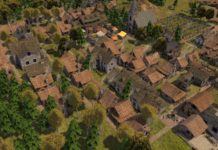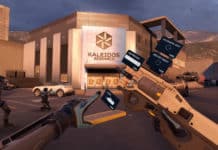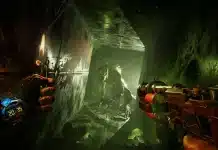Last Update on July 24, 2025
In the ever-evolving world of virtual reality, Bonelab VR stands out as both a technical showcase and a chaotic playground. Developed by Stress Level Zero, the game was released in September 2022 as the spiritual successor to Boneworks — a cult hit among VR physics nerds and headset-wearing daredevils alike. Bonelab is available on Meta Quest 2, Quest 3, and PC VR, and it wastes no time throwing you into a surreal, physics-driven sandbox where logic goes to die and ragdolls reign supreme.
But this isn’t just another VR shooter with floaty mechanics and fake immersion. Bonelab is powered by the Marrow1 interaction engine, pushing object weight, force, and balance to disturbingly accurate levels. Combine that with full-body avatar switching, built-in mod support, and a cryptic narrative that may or may not be a metaphor for game development hell — and you get one of the most divisive, ambitious VR experiments to date.
Is it revolutionary? Is it broken? Is it both at once?
Let’s find out.
1. Overview & Background
Bonelab is a physics-based action sandbox developed by Stress Level Zero and released on September 29, 2022 for Meta Quest 2, Meta Quest 3, and PC VR (Steam). Built as a spiritual sequel to 2019’s Boneworks, the game retains its predecessor’s DNA: raw interactivity, player-driven experimentation, and full-body VR immersion. But Bonelab isn’t just an update — it’s a broader, weirder, and more moddable vision of what a VR game could be if you threw out most of the rules and let chaos drive.
Unlike traditional VR titles, Bonelab drops you into a surreal multiverse after your in-game execution is mysteriously interrupted. From there, things get metaphysical. The game’s cryptic story — experienced non-linearly — explores themes of identity, simulation, and player agency, blurring the line between game logic and dream logic. But let’s be honest: many players come for the physics engine and stay for the mods.
Key Facts
| Feature | Details |
|---|---|
| Developer | Stress Level Zero |
| Engine | Unity with Marrow1 Physics |
| Release Date | September 29, 2022 |
| Platforms | Meta Quest 2/3, PC VR (SteamVR) |
| Play Modes | Single-player, Mod-supported |
| Average Playtime | 5–6 hrs campaign + infinite via sandbox/mods |
| Official Mods | Supported via Thunderstore & mod.io integrations |
2. Core Mechanics & Gameplay
At the heart of Bonelab is the Marrow1 Interaction Engine — a custom-built physics system that treats every object like it belongs in the real world. Boxes fall with weight. Doors swing with resistance. Bodies collapse with momentum and gravity that feel oddly personal. It’s not perfect — it’s often janky — but it feels like no other VR game.
Physics-Based Everything
Your hands interact with the environment naturally, from climbing ledges to grabbing enemies by the throat. Movement is handled via full locomotion and a surprisingly robust climbing system — although your actual room space and muscle mass will set limits you can’t mod away (trust us, we tried).
- Objects obey real-world physics: mass, inertia, momentum
- Weapons need to be physically handled: loading, aiming, recoil
- Full-body IK tracking for avatar presence and motion response

BodyLog System: Avatar Switching
Bonelab’s unique BodyLog system lets players switch avatars at any point — with each form affecting your physical abilities:
- A large brute can smash through objects but moves slowly
- A nimble character can access tight spaces and leap great distances
- A balanced human fits most general tasks
- Even a tiny avatar can crawl into ducts like some horrifying VR rodent
This mechanic unlocks complex puzzle-solving and traversal, transforming platforming sections into tactical physics trials. It also plays into the game’s story, as each form seems to represent a fragment of the protagonist’s identity.
Game Modes
Mode | Description |
|---|---|
| Campaign | A fragmented narrative with puzzle, combat, and parkour sequences |
| Sandbox | Pure experimentation — build, break, explore |
| Arena | Combat trials against waves of enemies |
| Parkour | Precision platforming and timing challenges |
| Mods | Native support for community maps, weapons, mechanics |
Watch Bonelab VR in Action
Source: Nemsk on YouTube
3. Visuals, Audio & Immersion
Bonelab’s visual identity is a mixed bag — part dystopian simulation, part vaporwave fever dream. The game doesn’t aim for photorealism; instead, it leans into a stylized, surreal aesthetic that reinforces its fragmented narrative. Environments feel sterile one moment and violently chaotic the next, mirroring the protagonist’s distorted sense of reality.
Visual Style & Design
- Engine: Unity (custom rendering pipeline)
- Art Direction: Stylized low-poly meets cyber-dream
- Lighting: Strong use of contrast and ambient occlusion for depth
- Performance: Quest 3 version has major visual and frame-rate improvements vs. Quest 2
- PC VR: Supports high-res textures and advanced lighting with capable GPUs
While visuals on Quest 2 suffer from frequent texture pop-in and reduced fidelity, the Quest 3 version offers a smoother experience thanks to enhanced GPU performance. On PC VR, Bonelab can look surprisingly crisp — if your rig doesn’t catch fire from too many spawned crates.
Audio & Sound Design
Sound in Bonelab isn’t just atmospheric — it’s reactive. The game uses dynamic audio cues tied to environmental physics and avatar states:
- Footstep sounds vary depending on body size and surface
- Combat audio adapts to weapon type and collision strength
- Synth-heavy soundtrack shifts between calm and chaos, reflecting narrative beats
4. Modding & Customization Features
If there’s one thing that extends Bonelab’s lifespan beyond its short campaign, it’s the modding ecosystem. From day one, Stress Level Zero made modding a core design pillar, offering tools and documentation for players to modify nearly every aspect of the game.
Official Mod Support
- Platforms: PC (Thunderstore), Quest 2/3 (LemonLoader, Mod.io)
- Formats: Custom avatars, weapons, maps, logic scripts
- Tools: Unity SDK + community-built mod managers
- Distribution: Centralized hubs via mod.io and Thunderstore
Installing mods on PC is plug-and-play, while Quest users can enable mods using LemonLoader — an unofficial but widely trusted loader allowing native sideloaded content.
Notable Community Mods (as of 2025)
| Mod Name | Description |
|---|---|
| Unofficial Patch | Fixes bugs and adds missing features |
| Lightsaber Combat | Physics-based melee with Star Wars vibes |
| GTA VR Maps | User-built city environments and vehicles |
| VR Spider-Man | Swing mechanics + wall crawling |
| Anime Overhaul Pack | Skins, soundtracks, ridiculous flair |
Mods transform Bonelab from a game into a living sandbox framework, with new gameplay loops, mechanics, and even entirely fan-made campaigns. It’s not just cosmetic — many mods significantly enhance gameplay systems or fix what the devs left rough.
5. Performance Across Platforms
Bonelab is available on three major VR platforms: Meta Quest 2, Meta Quest 3, and PC VR via Steam. But as you’d expect, performance varies wildly depending on where you play — from “smooth sandbox” to “framerate horror show.”
Meta Quest 2
- Resolution: Lower texture fidelity, downgraded lighting
- Framerate: Unstable in physics-heavy levels (drops under 60 FPS)
- Load Times: Noticeably long when switching scenes or spawning many assets
- Thermal Throttling: Extended sessions can cause heat-related lag
Verdict: Still playable, but expect jank. Mods are limited, and CPU-intensive moments can break immersion.
Meta Quest 3

- Resolution: Sharper visuals, better anti-aliasing
- Framerate: Stable across most levels (typically 72–90 FPS)
- Loading: Significantly faster asset streaming
- Modding: Compatible with LemonLoader (wider mod access)
Verdict: The ideal standalone headset for Bonelab in 2025. Better everything with fewer compromises.
PC VR (Steam)
- Resolution: Ultra textures, custom shaders, post-processing possible
- Framerate: Varies depending on rig — can hit 120 FPS+
- Headset Support: Oculus Rift S, Valve Index, HTC Vive, etc.
- Modding: Full compatibility with Thunderstore, mod.io, Nexus Mods
Verdict: The most powerful and flexible version. If you’ve got the GPU to match, you’ll get the smoothest, most moddable Bonelab experience.
6. Pros & Cons + Final Verdict
Pros
- Incredibly immersive physics with Marrow1 engine
- Unique full-body avatar switching adds tactical depth
- Flexible modding support across all platforms
- Active and creative community constantly expanding the game
- Runs well on Quest 3 and PC VR with proper hardware
Cons
- Janky performance on Quest 2 and weaker devices
- Fragmented, unclear storyline won’t appeal to everyone
- Steep learning curve for newcomers to VR mechanics
- Occasional bugs and physics glitches can break immersion
- Short main campaign unless extended with mods
Final Verdict
Bonelab VR isn’t trying to be a polished theme park ride — it’s more like a physics-based VR lab experiment gone wonderfully off the rails. It’s chaotic, ambitious, and sometimes broken… but never boring. Whether you treat it as a modding platform, a sandbox physics toy, or an existential puzzle with ragdolls, Bonelab rewards curiosity like few other VR games.
If you’re on Meta Quest 3 or PC VR, it’s a must-play.
On Quest 2? Prepare for a few technical bumps along the way.
And if you’re new to VR? Maybe… start with something less likely to toss you off a digital building.
Frequently Asked Questions (FAQ)
Q1. Is Bonelab available on Meta Quest 2?
A: Yes, Bonelab is available on Meta Quest 2. However, performance may suffer in complex levels due to hardware limitations such as frame drops and long load times.
Q2. Can I use mods in Bonelab without a PC?
A: Yes, if you’re using Meta Quest 2 or 3, you can use mods via LemonLoader, a third-party tool that enables modding directly on standalone headsets.
Q3. Does Bonelab have a campaign mode?
A: Yes, Bonelab includes a 5–6 hour narrative campaign. While it’s cryptic and non-linear, it serves as an intro to the mechanics and the sandbox world.
Q4. What’s the difference between Bonelab and Boneworks?
A: Bonelab expands on Boneworks by introducing avatar switching (BodyLog), native mod support, and availability on standalone headsets like the Quest 2 and 3.
Q5. Is Bonelab beginner-friendly for VR users?
A: Not really. The game expects players to understand free locomotion, physics mechanics, and VR interaction norms. It’s better suited for intermediate to advanced VR users.
By Yassine Kenzaoui — VR Expert & Editor @Ovrdoz
Since 2016, I’ve been testing VR games and hardware to share honest reviews, tips, and insights with the community.











